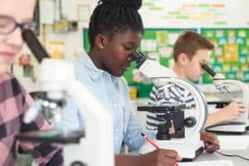Potential and Kinetic Energy Inquiry Lab
Middle School Inquiry Lab on Potential and Kinetic Energy
In this lab students will be introduced to the types of kinetic and potential energies and asked to identify which are present in a photograph. They will then be guided through the making of a simple Rube Goldberg machine and asked to identify the energies present.
Each inquiry lab will contain an essential question that will drive the lesson and make students think. For this lesson, the essential question is:
- What differentiates potential energy from kinetic energy?
BACKGROUND INFORMATION AND MATERIALS LIST:
Students will begin the lab by reading the essential question and background information. This can be done individually, as lab groups, or as a whole class. If you consider lab groups, you also might include some type of whole class formative checks before digging into the lab.

Materials List:
- pencil
- lab sheet
- marble
- ping pong ball
- 10 dominoes
- plastic cup or container
- Independent level materials:
- string
- 10 wooden blocks
- tissue
PROCEDURE:
For this lab, students will first familiarize themselves with the differences between potential and kinetic energy by properly labeling different examples in a chart. After that, they'll examine photographs and identify the type of energy pictured.
Next, they'll move over to a tabletop and set up 10 dominoes in a line, with each domino approximately 1 cm from each other. Students will ensure that the dominoes are positioned with enough room for the plastic cup to sit on its side between the dominoes and the end of the table. The open mouth of the cup should face toward the dominoes.
They'll then place a ping pong ball between the end of the line of dominoes and the open mouth of the cup, and then they'll start rolling the marble into the dominoes. The goal is to make the marble roll into the dominoes, resulting in the dominoes toppling over, hitting the ping pong ball and rolling it into the cup. Students are encouraged to try at least three times to successfully execute the machine, modifying it slightly and coming up with ways to improve the machine each time.
CHECK FOR UNDERSTANDING:
At this point in the lab, students will be checked for understanding by answering questions about their findings. Here is one that comes with the lab:
- How are kinetic and potential energy different?
CONCLUSION
Students will go back to the essential question and write a CER (Claim, Evidence, Reasoning) to conclude the lab. Once completed, students will reflect back on their learning by answering the following questions:
- List the types of potential and kinetic energy.
- What effects kinetic energy?
- What determines the potential of energy? Give an example.
MODIFIED AND INDEPENDENT INQUIRY VERSIONS
All of the Kesler Science inquiry labs come with three different modification levels. Each lab is differentiated using the icons below.
STANDARDS ALIGNMENT
TEKS: 6.8A – Compare and contrast potential and kinetic energy.

Download Over $100 in FREE Resources
For Middle School Science
Simply create a login below and gain immediate access to a selection of our Kesler Science product line worth $100 - for FREE. There's a full version of every product type! You'll also join tens of thousands of middle school science teachers who receive timely tips and strategies straight to their inbox.





